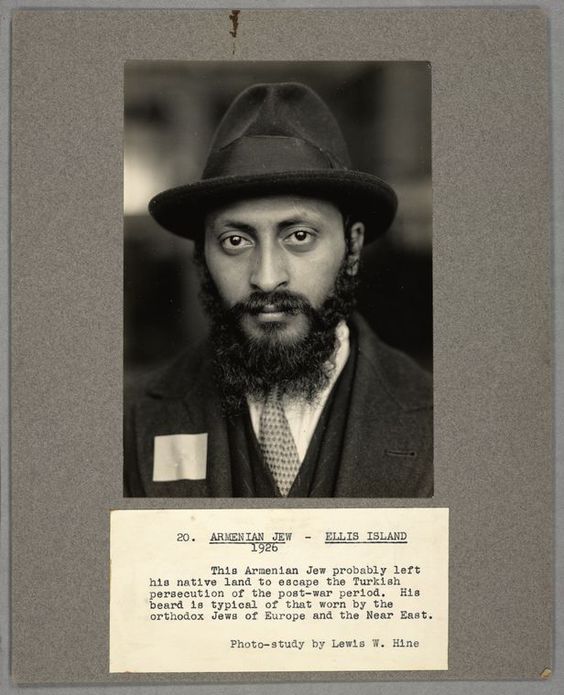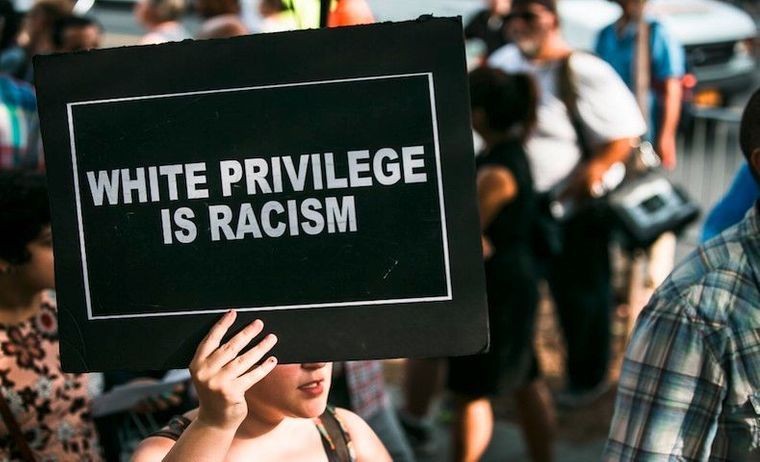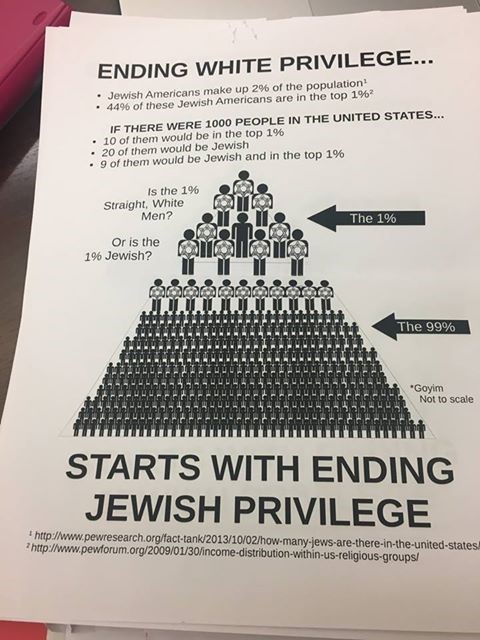How did Jews come to be defined as “white” by a critical discourse in vogue today? Why do we label Jews as dominant or privileged – and Israel as a colonial entity practicing apartheid motivated by Jewish and white supremacism? Part one of an essay by Balázs Berkovits on the supposed color of Jews…
Read part II here

“We don’t fit into ‘oppressor’ or ‘oppressed’ categories. We are both privileged and marginalized, protected by those in power and yet targeted by the same racist lunatics as those who target people of color. The hatred we experience on campus has nothing to do with the Israeli-Palestinian conflict. It’s because Jews defy anti-racist ideology simply by existing. So it’s not so much that Zionism is racism. It’s that Jewishness is.[1]”
These sentences uttered recently by an American Jewish student express something essential: Jews are never considered sufficiently white by the alt-right, those, who harbor a traditional type of racism and antisemitism; at the same time, Jews are too white for the “social justice warriors”, the critics of whiteness, who not only deny the threat of antisemitism, but accuse Jews of being racist, due to their supposedly unacknowledged but obvious whiteness[2]. Jews find themselves in this inextricable double-bind, perhaps even double double-bind, related to the fact that discourse on “race”, has been emerging more and more forcefully as the natural vernacular of social critics and activists as well.
How have Jews come to be defined as “white” in much of present-day critical discourse? Why has it become an important matter to be able to describe Jews as being part of the dominators and privileged in society, and to label Israel as a “settler colonial” entity based on Jewish, or at least, white supremacy, as a practice in apartheid? “Whiteness” symbolizes majority status and dominance, and, in a global perspective, even conquest and subjugation of other ethnic/national groups. True, when Jews are dubbed “white” in this sense, it certainly has a special flavor to it.
Birth in America: Race and ‘Whiteness’ Studies
Discourse on “whiteness” originated in the United States, where, unlike in Europe, color and racial classification have always played a major role. But it has steadily been exercising more and more influence in Europe as well, as the novel, racial (self-)understanding of social groups, and “race-based” critique are gaining ground, underscored by “critical race” and “critical whiteness theories” in academia. In this framework it is asserted that Jews, at least Ashkenazi Jews, constituting the majority of American Jewry (but theirs is the expandable paradigm case for every other Jewish group everywhere), are unquestionably white, in spite of their former status as an ethnic and religious minority, and their European history of extreme persecution culminating in the Shoah. The label of “white” is not only meant to express that Jews are not victims of racism, or at least “systemic racism” anymore, as they are not discriminated against on ethnic or religious grounds, or that they have reached a high level of assimilation in the host societies, but also that they enjoy “white privilege”, and that in many instances are even active in maintaining “systemic racism” directed against people of color.
For sure, whiteness is understood in a critical mode, first, in the reversal of the evaluation of processes of acculturation and social mobility, henceforth regarded as negative phenomena; and second, in the presentation of majority, “white” society as essentially racist. These reevaluations are destined to give the impression that Jews are in fact part and parcel of the oppressive majority of multicultural societies, in which people of color are oppressed on a racial basis. This perception is reinforced by the image of Israel, a supposedly alien entity in the Middle East, imagined on the model of historical white settler colonies[3].
According to the historian Moshe Rosman, the novel critique of Jews emerging in what he calls the “new academy” (heavily influenced by postcolonial theory, intersectional theory, and identity politics), but also in public discourse, is stemming from contemporary “multiculturalism” (understood in a rather narrow sense as identity politics), which enacted a sort of paradigm shift with regard to the criteria of integration. Previously, says Rosman, minorities were encouraged to become a “subculture” by moving away from the periphery of society, toward the adoption of the values of the majority, while preserving some distinctive, idiosyncratic cultural traits. With the change from a “pluralist” to a “multicultural” paradigm, assimilation and acculturation not only became much less valued than before, but came to be frequently criticized. Therefore, the representation of Jews as a “successful” minority could not pretend to take part of this new multicultural constellation, as preference was given to what Rosman calls “countercultures”, which understand themselves in a strict opposition to what is considered the majority culture. “Multiculturalist critics consistently speak about Jews, Judaism and Jewishness as conservative, even reactionary and oppressive, aligned with the established powers of hegemony that seek to exclude and disempower people of color and other minorities.[4]”

All this can be summarized in a concise formulation by Pamela Paresky: “At a time when the moral imperative is to ‘be less white’, there is no identity more pernicious than that of a once powerless minority group that, rather than joining the struggle to dismantle whiteness, opted into it[5]”.
The novelty of “critical race theory” and “critical whiteness studies”, those increasingly popular disciplines, which belong to the “new academy”, has been to treat “whiteness” as a historical concept, striving to de-essentialize it, while seemingly distancing it from its “perceptual” meaning as skin color. Thus, people, groups can in fact become white, whiteness being something that can be achieved through a historical process of acculturation/assimilation, qualified and interpreted by the methods of social history. “Whiteness” was meant to be the endpoint of an empirically discovered historical process, when, after World War II, discrimination against Jews and antisemitism has gradually subsided in the US (although the ever-growing number of antisemitic attacks during the last two decades firmly refutes the latter supposition, even so if it is only reluctantly acknowledged, or often qualified as a “non-systemic” phenomenon).
It has to be noted that the concept of “whiteness” is somewhat amorphous. In fact, its multiple and contradictory meanings always come to the fore in this framework in which Jews are seen as becoming white (in the socio-economic sense), along with the supposition that they have always been white from the beginning (in a “racial” sense, regarding skin color[6]) – as the latter is taken to be an essential prerequisite of real integration. That is to say, there is an inherent tension between two conceptions of whiteness that is reflected in the new academy’s discourse on Jews: whiteness can be perceived as either the result of assimilation or an innate reality of skin color. While the new academy purports to privilege the former, these same elements often draw on the suppositions of the latter. The circularity of the argument describing Jews as white, due to these multiple and never-clarified meanings, is obvious, such as in Karen Brodkin’s pioneering book on “Jewish whiteness”, in which the name “Euro-ethnics” seems to refer implicitly to skin color, subverting the original thesis according to which whiteness is a historical construction:
“As with most chicken-and-egg problems, it is hard to know which came first. Did Jews and other Euro-ethnics become white because they became middle-class? That is, did money whiten? Or did being incorporated into an expanded version of whiteness open up the economic doors to middle-class status? Clearly, both tendencies were at work (…) The 1940 Census no longer distinguished native whites of native parentage from those, like my parents, of immigrant parentage, so Euro-immigrants and their children were more securely white by submersion in an expanded notion of whiteness[7]”.

Notwithstanding, or maybe thanks to these ambiguities, the “white” label has both the effects of erasure, as the qualification by definition cancels the minority status of a group, and of a very sharp critique, as the white majority is emphatically denounced as racist, or at least as benefiting from “systemic racism” even if unwittingly. “White”, denoting “white privilege”, “white supremacy” etc. has become one of the most important concepts of contemporary criticism, therefore labeling people or groups as such is far from being a anodyne element of an innocent social history. On the contrary, assimilating Jews to whiteness conceived in this manner reveals a clear political ambition: to assert that the fundamental issue is racial even in contemporary Western societies, and furthermore, that this fundamental racial issue is linked to the color line between whites and blacks, while everything else should be considered negligible. Thereby, the particular traits of antisemitism, that is, everything that renders it different from racism, becomes irrelevant.
The whiteness framework at once helps to prove that Jews are not a minority anymore, as they are devoid of “color”, thereby erasing Jews as a group and also antisemitism, declaring them obsolete, quasi non-existent; and, in an intensified critical or accusatory mode, it suggests that Jews are in fact the paradigmatic oppressors, as they are endowed with the emphatically understood “white” color. In contrast, it has to be noted that interestingly enough, unlike other “white ethnics”, they can still be identified as a clear-cut group inside the “white” collectivity.
Race and ‘Whiteness’ come to Europe
Jewish whiteness transplanted to Europe (the origin of most American Jews) manifests itself in opposition to (colored) Muslims, interpreted as a temporal succession, in which antisemitism pertains to the past, whereas contemporary racism manifests itself almost exclusively in Islamophobia[8]. For example, Enzo Traverso develops this kind of thought
More radical is the take of Houria Bouteldja[9], the founder of the “movement of the indigenous” in France. Not only does she take Jews to be white, which she interprets as a “choice” on their part but exhorts them to get rid of this ascribed whiteness. In her mind, “indigenous” and white people have faced down each other since the beginning of colonial times, like two immovable blocs. The Jews are situated in between them, and, by fully adjusting to the white majority, have betrayed their original, non-white condition. They are now “whitened”, having become the “dhimmis of the Republic” (dhimmi refers to the subordinate nature of Jews and Christians in historical Islamic societies). In this respect, Bouteldja emphasizes not so much the social integration of Jews and their high economic status in the Western world; what is more important to her is their “political” integration into a white, “racist” society and even world system, comprising Israel: Jews as Zionists are instrumentalized by white colonialism, and as such, are temporarily exempt of otherwise eternal white antisemitism and racism, which now entirely turns against Muslims (in the West, but also in the Middle East by way of Israel oppressing the Palestinians). Now the task prescribed by Bouteldja for Jews is to return to their original, non-white condition by partaking in the fight against Zionism (a European invention to exonerate the Continent from the crime of the Shoah and to build a white colony in the Middle East, and with which the Jews have been duped). Zionism for her epitomizes the most important, “historical confrontation” with white people.

The Critique of “White Jews”
The qualification of “white” applied to Jews omnipresent also in academia seems to hark back to some pre-social scientific critical agendas, such as the Enlightenment critique of “Jewish mores and civilizational underdevelopment”, and later antisemitic critiques of malignant modernity and “profiteering mentality”. For Enlightenment writers the question was whether Jews as a group deserved equal civil and political rights, and whether education would rid them of their traditional mores supposedly incompatible with modern society. ” Beneath this set of issues lay two central questions: did Jews constitute a distinctive people, race, or nation; and did an inherent dichotomy exist between Judaism and modernity?[10]”. With emancipation acquired, criticism was formulated later on in terms of unmerited Jewish advantages or “Jewish overrepresentation”, often turning into accusations of Jews subduing parts or the whole of the majority society (still having repercussions in today’s conspiracy theories). So Jews are either criticized for being backward and unfit for integration, or for epitomizing corrosive modernity, and being its utmost beneficiaries (or both at the same time)[11]. “A switch had thus taken place between the Enlightenment discourse that underpinned ‘the Jewish Question’ and Marr’s formulation of ‘antisemitism.’ Jews no longer represented atavism and backwardness; they were now also tagged as the vanguard of corrosive modernity[12]”. The trope of excessive overrepresentation in dominant positions and of dominating majority society in nascent capitalism was especially characteristic in Central and Eastern Europe, where it has survived even after World War II, and in many respects until our day.
How does the critique of “white Jews” relate to these tropes? How is Jewish “prominence”, “exceptionality”, “domination” reinterpreted in contemporary criticism? That the memory of the Shoah and what some people perceive as the “undue primacy” of Jewish suffering in collective memory constitute the major stakes of many discussions informed by a postcolonial agenda, has already been well established[13]. But this idea of the supposedly privileged position of Jewish memory in the face of other human suffering has been recently complemented by the enumeration of other privileges, such as the position of Jews in the class structure; the lack of discrimination targeting them, contrary to other (visible) minorities; the allegedly waning antisemitism in the Western world; and even the unduly received “enhanced protection” from state authorities, etc.
Furthermore, the critical (or even specifically moral) aspect of “Jews becoming white” aims to show that Jews did not “deserve” their elevated place in society: it was not due to their talent, hard work, perseverance etc. The achievements in social mobility and acculturation are not attributed to Jews themselves as actors[14], but to the social conditions favoring them (while being disadvantageous for others). This is in fact the type of explanation with which the discourse on “Jewish whiteness” intends to demonstrate its social scientific credentials, by countering individualistic or actor-based interpretations; however, it is completed by a critical edge, in which the methodological level (a holist explanation) will be conflated with the ethical-critical level (if Jews did not achieve their status due to their individual qualities, they should not have achieved it at all). This indicates a clear mismatch between the interpretive and the critical intentions. (That is to say, that the methodology and form of the inquiry, which should be descriptive, is immediately placed in the service of normative conclusions.) However, this should not come as a surprise if we consider that whiteness scholars in their evaluations, most of the times tacitly, but sometimes even explicitly, have endorsed some of the anti-Jewish stances of certain black activist intellectuals in the sixties and seventies, such as James Baldwin[15] and Harold Cruse[16]. We could even say that their critique of Jews is mostly the rationalization of these positions by seemingly having recourse to some social-scientific concepts and tools; nevertheless, they still remain a “travesty of social theory[17]”.

For whiteness scholars, Jews’ social mobility signals a “betrayal” of an authentic minority position along with the alliance with the capitalist system, the wholehearted identification with white America, and even anti-black racism[18]. This critique, by sharpening the critical edge contained in “white” goes one step further than the qualification of unmerited social integration and privilege. Now an ethically even more emphatic, condemnable “contribution” is being highlighted – as Jews have supposedly been contributing to the solidification of white racial and economic domination, not only by demonstrating that it is in fact possible for a minority to become successful, but also by becoming effectively racist
In this kind of social-historical interpretation, talk about “Jewish whiteness” is intended as a counter-apology (an indictment!) in a triple sense. First, what Jews have accomplished is not due to their action, but to social circumstances and to the fact that they have been accorded all the opportunities that others, and mainly blacks have not; second, this upward mobility cannot be deemed as positive, as now Jews are not only benefiting from, but contributing to white society’s racism (for majority society is qualified as white supremacist, or at least exerting a heavy bias in favor of white people); and third, this purported racism is also exerted by intentional action on the part of Jews or at least some leading “Jewish” intellectual and political figures. There is a sudden change in the form of explanation: whereas status attainment was not due to Jews’ (intentional) action, now their supposed racism is conceived of as being at least partly conscious and intentional, which opens up the space for additional moral and political critique.
Read Part II here
Balázs Berkovits
Balázs Berkovits was born in Budapest and lives in Tel Aviv. He is a sociologist with a PhD in philosophy, pursuing research in the Comper Center at the University of Haifa, the London Centre for the Study of Contemporary Antisemitism (LCSCA) and MEMRI (Jerusalem). He is also the book review editor of the Journal of Contemporary Antisemitism. At present, his work concerns the re-emergence of the “Jewish problem” in contemporary works of philosophical, social and political criticism. Occasionally, he also writes on the political and social situation in contemporary Hungary.
Notes
| 1 | Blake Flayton from George Washington University, cited in Bari Weiss, “Stop Being Shocked”, Tablet Magazine, Oct. 5, 2020, https://www.tabletmag.com/sections/news/articles/stop-being-shocked |
| 2 | See also Pamela Paresky, “Critical Race Theory and the Hyper-White Jew”, Sapir, Vol. 1., Spring 2021, https://sapirjournal.org/wp-content/uploads/2021/04/Sapir_VolumeOne.pdf |
| 3 | The academic review Settler Colonial Studies, founded in 2010, has already published three special issues on Israel; generally speaking, almost one third of the articles from these 10 years deal exclusively with Israel, and certainly many more at least mention it in a so-called comparative perspective. |
| 4 | Moshe Rosman: “From Counterculture to Subculture to Multiculture: The ’Jewish Contribution’ Then and Now”, in: Jeremy Cohen – Richard I. Cohen (ed.): The Jewish Contribution to Civilization. Reassessing an Idea, The Littman Library of Jewish Civilization, Portland, Oregon, 2008. |
| 5 | Paresky, ibid., p. 23. |
| 6 | More in detail about the equivocal nature of the “whiteness” conception, see Peter Kolchin, “Whiteness Studies: The New History of Race in America”, The Journal of American History, Vol. 89, No. 1, 2002; Balazs Berkovits, |
| 7 | Karen Brodkin, How Jews Became White Folks?, Rutgers University Press,1998, 36.i |
| 8 | Matti Bunzl, Anti-Semitism and Islamophobia: Hatreds Old and New in Europe, Chicago, IL: University of Chicago Press, 2007. For an insightful analysis of this tendency, see: Glynis Cousin & Robert Fine, “A Common Cause. Reconnecting the Study of Racism and antisemitism”, European Societies, 2012, Vol. 14, No. 2, 166-185. |
| 9 | White, Jews, and Us. Toward a Politics of Revolutionary Love, La Fabrique, 2016. |
| 10 | Jonathan Judaken, “Antisemitism and the Jewish Question”, in: The Cambridge History of Judaism, Vol. VIII., Cambridge University Press, 2017, 561. |
| 11 | See Marcel Stoetzel, “Sociology’s Case for a Well-Tempered Modernity. Individualism, Capitalism, and the Antisemitic Challenge”, Marcel Stoetzel (ed.), Antisemitism and the Constitution of Sociology, University of Nebraska Press, 2014. |
| 12 | Judaken, ibid, 570. |
| 13 | For example: Philip Spencer, “Imperialism, Anti-Imperialism and the Problem of Genocide, Past and Present”, History, 2013.; Balázs Berkovits, “Social Critique and the Jewish Problem”, in: Alvin Rosenfeld (ed.): Anti-Zionism and Antisemitism. The Dynamics of Delegitimization, Indiana University Press, 2019. |
| 14 | “the myth that Jews pulled themselves up by their own bootstraps” (Brodkin, ibid, 50.) |
| 15 | See his famous “Negroes are Anti-Semitic Because They’re Anti-White”, in: Nat Hentoff (ed.), Black Anti-Semitism and Jewish Racism, New York, R. W. Baron, 1969. |
| 16 | The Crisis of the Negro Intellectual, New York, William Morrow Co., 1967. |
| 17 | Marcel Stoetzel, ibid., p. 78. |
| 18 | “If not instances of outright racial hostility, Baldwin was suggesting, much Jewish wealth (even when relatively modest) was generated through catering to captured black markets”. (Jane Anna Gordon, “What Should Blacks Think When Jews Choose Whiteness? And Ode to Baldwin”, Critical Philosophy of Race, Vol. 3, No. 2, 2015, 231.); Jews being the beneficiaries of “the racial metaorganization of American capitalism” (Brodkin, p. 178). “In the main, argued Baldwin, Jews and their white Christian counterparts embraced a U.S. identity that made them sentimentally fond of a polity that created unique life chances for them and were therefore disinclined to grapple with historical policies and patterns that made the United States that blacks inhabited very different” (Gordon, idem, p.232.) |









